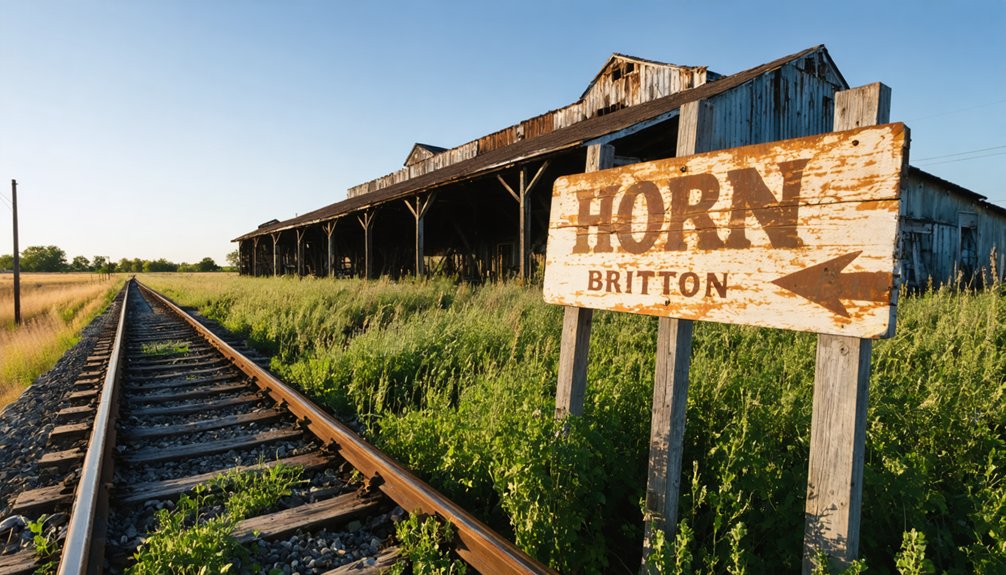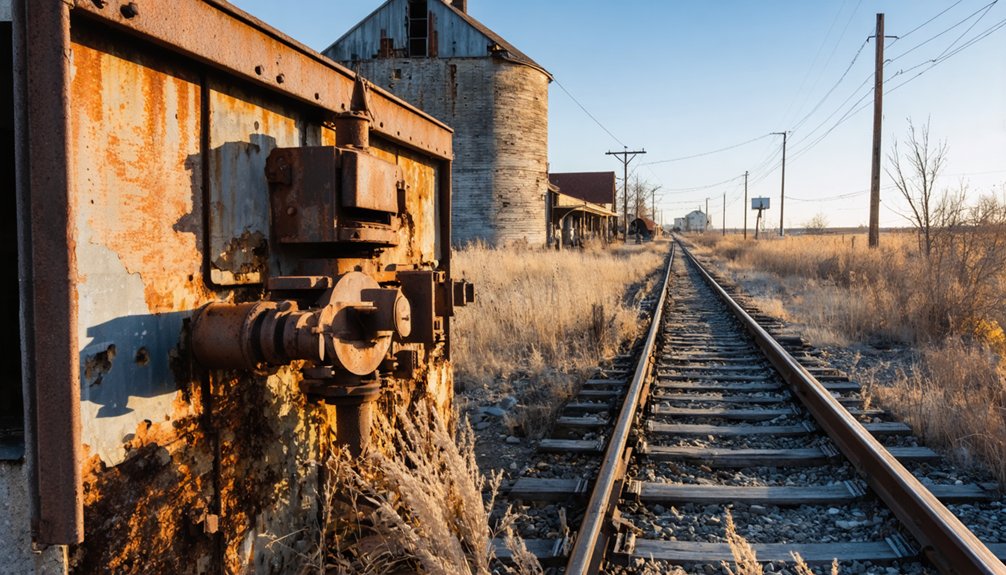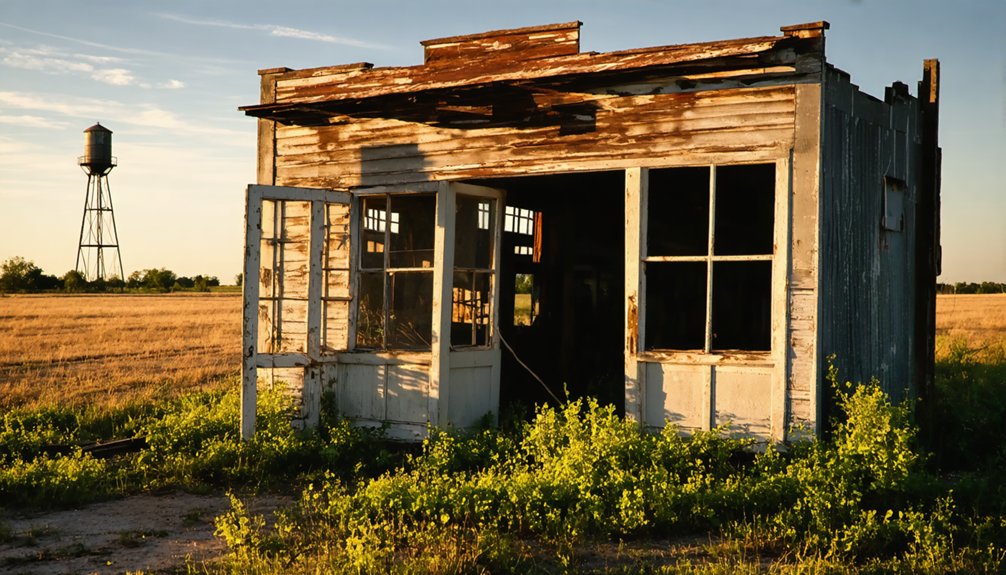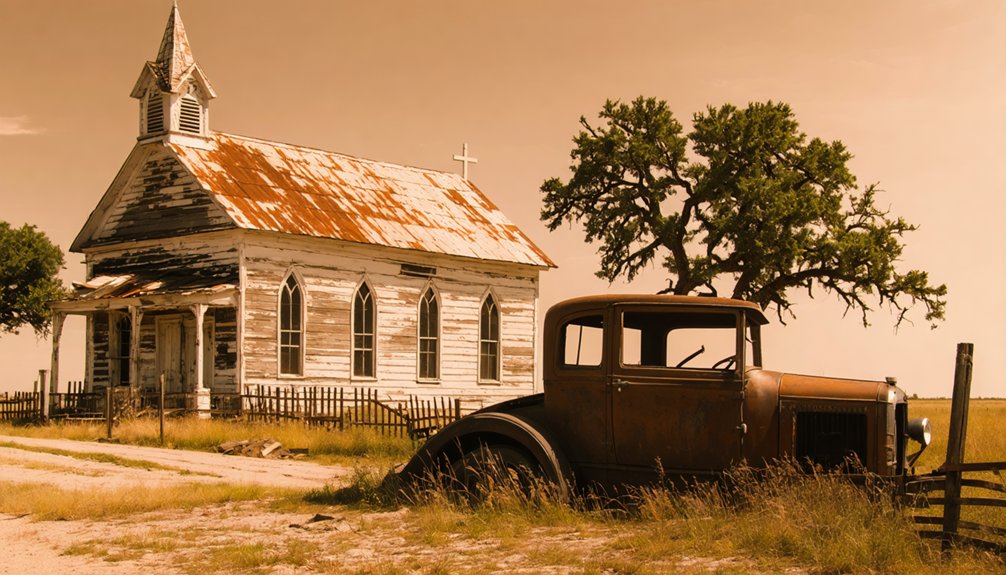You’ll find Britton, a ghost town in Ellis County, Texas, along the former Texas and New Orleans Railroad line. Originally named Helland in 1895, the town flourished with 300 residents by 1925, boasting a bank, churches, and essential services. When Highway 287 bypassed Britton in the 1940s, the population dwindled to just 30 today. The well-preserved cemetery, deteriorating bank building, and historic houses tell a deeper story of this once-bustling railroad community.
Key Takeaways
- Britton declined from 300 residents to just 30 after Highway 287 bypassed the town in the 1940s.
- The abandoned Old Britton Citizens Bank stands as the last commercial structure, symbolizing the town’s deterioration.
- Founded in 1895 along the Texas and New Orleans Railroad, Britton thrived as a commercial hub until transportation routes changed.
- Historic houses remain partially inhabited while others decay, with the well-maintained Britton cemetery preserving the town’s legacy.
- Urban development from nearby Mansfield threatens to absorb the remaining structures of this former Ellis County railroad town.
The Railroad Town’s Three Names

The Texas and New Orleans Railroad played a pivotal role in establishing what would become Britton, Texas in 1895.
The settlement’s Helland history began when it was named after Joseph Helland, a railroad passenger agent.
You’ll find early records using both Helland and Hellandville interchangeably, reflecting the strong influence of railroad personnel on the community’s identity. Similar to other place name changes, this evolution required careful documentation to avoid confusion.
The town underwent a final name change to Britton in 1896, marking the beginning of its most well-known identity.
Early Settlement and Town Planning
Following its establishment in 1895, Britton’s early development reflected careful town planning and strategic positioning along the Texas and New Orleans Railroad line.
You’d have found a well-organized settlement with two daily passenger trains serving the growing community. Like early settler Brit Bailey before them, residents faced challenges with local Indian tribes. The area’s military history was shaped by settlers like Bailey who had served in the War of 1812. Despite settlement challenges, including early conflicts with Karankawa Indians, the town quickly established crucial community infrastructure.
George Magee’s land donations enabled the construction of the cemetery, Methodist Church, and school, while G.W. Maynard provided space for the Baptist Church.
By 1925, you could’ve walked through a thriving town of 300 residents, complete with two gins, multiple doctors’ offices, various stores, a bank, and a restaurant.
The community’s careful planning guaranteed balanced growth, with essential services like a blacksmith, barber, and ice house serving daily needs.
Peak Years of Growth and Commerce
By 1925, Britton had reached its pinnacle as a bustling commercial hub, where you’d find over 300 residents participating in a vibrant local economy. You could shop at multiple stores, dine at a restaurant, visit the drug store, or handle your finances at the Britton Citizens Bank.
Much like cotton and grain industries that sustained Bartlett, Texas, Britton’s economic prosperity was closely tied to agriculture. The town’s economic growth was driven by its strategic location on the Texas and New Orleans Railroad, with twice-daily stops facilitating trade and travel. Sadly, today the last bank building has been demolished, marking the end of an era for this historic town.
Community services thrived with three doctors, a barber, and essential agricultural infrastructure including two cotton gins and a grain elevator.
F.S. Windle’s grain elevator promoted small grain farming, while an egg-processing center diversified the local economy.
The railroad’s presence, combined with these commercial establishments, created a self-sustaining community that served both residents and surrounding rural areas.
Religious Life and Community Spirit
During Britton’s formative years, religious institutions emerged as cornerstones of community life, with the Methodist Church near the town cemetery on Noah Street serving as the earliest spiritual anchor.
The Methodist Church on Noah Street stood as Britton’s first spiritual beacon, uniting townsfolk in faith and fellowship.
Similar to the town of Sweet Home, which was established by former slaves, Britton saw community-driven development centered around faith.
You’ll find the Baptist Church established on G.W. Maynard’s donated land, followed by the Catholic Church‘s arrival in 1941, reflecting the town’s growing religious diversity.
Religious gatherings extended beyond worship, strengthening community identity through shared social activities. Like many of the 511 ghost towns scattered across Texas, Britton’s religious heritage remains a testament to its vibrant past.
The cemetery, donated by the McGees in 1895, grew from 274 markers in 1980 to 331 by 1999, telling the story of Britton’s faithful.
Churches provided stability during economic changes, while land donations from pioneers like George Magee and G.W. Maynard demonstrated their commitment to establishing lasting spiritual foundations that would shape local customs for generations.
Educational Development and Social Activities
You’ll find that Britton’s educational story began with a single school built on land donated by George Magee, serving the town’s children during its prosperous years.
The Methodist and Baptist churches supplemented formal education through Sunday schools and youth programs, creating a rich learning environment that extended beyond traditional classrooms. The town’s decline mirrors many Texas communities where population shifts to urban centers contributed to their transformation into ghost towns. Recent developments show new housing complexes bringing fresh life to the area.
As population patterns shifted, you can trace how Britton’s school district eventually merged with neighboring Midlothian and Mansfield districts, marking the end of its independent educational era.
School Growth Over Time
The establishment of Britton’s first school on George Magee’s donated land marked the beginning of the town’s educational development in the early 1900s.
The school’s growth paralleled the town’s expansion, reaching its peak during the 1920s when the population hit 300 residents. School demographics reflected the tight-knit nature of this rural Texas community, while strong community engagement was evident in the coordination between educational and religious activities.
- The school operated alongside Methodist and Baptist churches, creating an integrated social hub.
- Local doctors, businesses, and a post office supported the school’s central role.
- By the 1940s, Highway 287’s rerouting triggered declining enrollment, leading to eventual consolidation with Mansfield and Midlothian districts.
Church Educational Programs
Beyond formal schooling, Britton’s churches played an essential role in educating the community from the town’s earliest days. You’d find Sunday schools and Bible study groups teaching not just scripture, but fundamental reading and writing skills.
Church literacy programs served both children and adults, while religious education reinforced community values that helped bind residents together.
The churches didn’t just focus on education – they became vibrant social hubs where you could attend potlucks, holiday celebrations, and youth activities. These gatherings strengthened the town’s social fabric and provided vital support during economic hardships.
While formal schools eventually emerged, church educational programs adapted and continued supplementing public education. The impact of these church-based initiatives remained evident through higher literacy rates and stronger community bonds until Britton’s eventual decline.
Agricultural Innovation and Local Economy
While many rural Texas communities relied solely on cotton farming, Britton’s agricultural economy diversified through F.S. Windle’s construction of the town’s first grain elevator. This innovation encouraged farmers to expand beyond traditional crops into small grains, establishing Britton as a regional agricultural hub.
- You’d find two bustling cotton gins – one cooperative operation south of the railroad’s west end, and a farmer’s gin to the north of the east end – providing essential cotton processing services.
- The town supported multiple agricultural ventures including an egg-processing facility, while maintaining three stores, a bank, and other essential services.
- By 1925, you could count about 300 residents enjoying Britton’s economic prosperity, though this would decline to 200 by 1932 as transportation routes shifted and larger districts absorbed the community.
Transportation Changes and Town Decline

Despite Britton’s early agricultural success, significant transportation changes in the mid-20th century would reshape the town’s destiny.
You’ll find that Britton’s transportation legacy began shifting dramatically when Highway 287 was built four miles west in the 1940s, bypassing the once-bustling railroad town. The economic transformation was swift – businesses that had thrived on railroad traffic began to close as commerce moved to the new highway corridor.
The decline accelerated as passenger trains stopped running and freight service diminished. Without its rail lifeline, Britton’s population plummeted from 300 to just 30 today.
You can trace the town’s absorption into larger communities like Mansfield and Midlothian directly to these transportation changes, as residents sought better connections to regional centers and economic opportunities.
Modern Day Remnants and Urban Absorption
As you explore Britton today, you’ll find a landscape caught between its ghostly past and encroaching suburban future.
With only 30 residents remaining from its 1920s peak of 300, the town stands as a monument to rural Texas history while facing intense urban encroachment from nearby Mansfield.
Like a fading photograph, Britton clings to its rural roots as Mansfield’s suburban shadow looms ever closer.
- The old Britton Citizens Bank’s deteriorating walls and foundation remain as the last commercial structure, though its roof has collapsed.
- Several historic houses still dot the landscape, some inhabited while others slowly decay without preservation efforts.
- The well-maintained Britton cemetery, established in 1895, contains over 300 marked graves and provides a lasting connection to the town’s heritage.
Modern development now closes in within feet of these historic remnants, signaling Britton’s likely absorption into Mansfield’s expanding city limits.
Historical Impact on Ellis County Development

The arrival of the Texas and New Orleans Railroad in northwest Ellis County sparked Britton’s transformation from open prairie to a thriving commercial center.
You’ll find the railroad’s significance evident in how it shaped the town’s very identity, named after railroad employees and built alongside the tracks where passenger trains stopped twice daily.
The economic transformation was remarkable as Britton evolved into a bustling hub of commerce.
You’d have seen two cotton gins processing local harvests, while F.S. Windle’s grain elevator encouraged farmers to diversify into small grains.
The town’s business district flourished with stores, a bank, and various services.
This railroad-powered prosperity supported a peak population of 300 in 1925, with churches and schools serving as essential community anchors until newer transportation routes eventually diminished Britton’s prominence.
Frequently Asked Questions
What Natural Disasters or Significant Weather Events Affected Britton’s Development?
Like a gentle erosion, you’ll find no catastrophic disasters struck Britton. Severe storms and wind damage gradually wore down structures, but there’s no record of major flood impacts or drought effects shaping its fate.
Were There Any Notable Crimes or Law Enforcement Incidents in Britton?
You won’t find documented crime incidents or law enforcement activity specific to Britton. While nearby towns experienced a 1905 double murder and 1939 bank robbery, these weren’t directly connected to Britton.
What Native American Tribes Originally Inhabited the Britton Area?
You’ll find the Lipan Apache and Tonkawa tribes dominated the area’s tribal history, with some Karankawa presence nearby. Their cultural impact shaped early settlement patterns before Anglo-American expansion pushed them out.
Did Any Famous or Historically Significant People Come From Britton?
Like a quiet stream flowing through history, you won’t find famous residents of national renown here. H.C. Britton, the railroad conductor, and George Magee, a land donor, held local historical significance.
What Was the Average Property Value in Britton During Its Peak?
You’ll find exact property market values weren’t documented, but economic factors suggest modest prices during the 1920s peak, when small-town Texas real estate remained relatively affordable for independent homeowners.
References
- https://www.mansfieldtexas.gov/1397/Britton
- https://en.wikipedia.org/wiki/List_of_ghost_towns_in_Texas
- https://en.wikipedia.org/wiki/Britton
- https://www.texascitytx.gov/395/The-Britton-Family
- https://www.oklahoman.com/story/news/2000/06/04/the-soul-of-britton-ok/62195295007/
- https://www.ghosttowns.com/states/tx/britton.html
- https://www.texasescapes.com/TOWNS/BrittonTexas/brittontx.htm
- https://www.tshaonline.org/handbook/entries/britton-tx
- https://www.txgenwebcounties.com/ellis/_ghost_towns/Britton_Texas.html
- https://www.texascitytx.gov/388/Founding-Families



